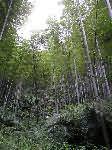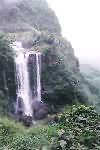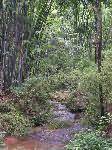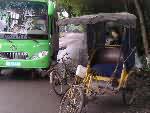- Getting around Lijiang. Dont stay in the Old Towns more than 2 days, there is nothing to do. KRISS Oct 9, 2013 05:46
- 2013 Beijing Temple Fair BENNYLAU Feb 26, 2013 03:29
- Malaysian traveling from KUL - LAX vis Shanghai PVG ZATI_DY Jan 3, 2013 20:15
A drop in the Bamboo Sea
- Views: 2464
- |Vote: 0 0
- |Add to Favorites
- |Recommend to Friends
As I stood up my digital camera dropped from the strap around my neck. The toggle had accidentally released and I watched hopelessly for a moment as the camera hit the ground and rolled into the water. I was standing on a large flat rock at the time which under natural circumstances would have only had a thin film of water a few millimeters deep flowing across the width of it, but a man made trench some 15cm wide and 10cms deep now diverted the water flow from one side to the other and this is where the camera came to rest - in deep water.
I quickly retrieved it, opened the battery and card cases to remove them before they could get wet and my friend and some other tourists handed me tissues to quickly wipe away the water. It was hard to tell how much damage it had suffered but I knew one thing. I had to dry it somehow. At home I would have turned on the oven and left it by the door using the escaping heat to evaporate any moisture. Another helpful tourist suggested we use a hairdryer which of course was a great idea but where would I find one of those. I seldom use one, never travel with one and few of my Chinese friends even own one.
We were in one of China’s best-known Bamboo Forestry Reserves in southern Sichuan miles from any major town and were staying in a small village that services the hordes of tourists that swamp the park during the Golden Week holidays. What was even more ironic was the name of the valley – poetically dubbed ‘Forgetting Your Worries Valley’ – and one of the most picturesque spots in the park, complete with piped music and night-lights. Where else should it have happened?
The Bamboo Museum, the only one of it’s kind in the country and most likely the world was something we should not miss. Several halls display a variety of the thirty different bamboos found in the area, many of the uses of bamboo over the centuries from furniture and flooring to tooth picks and chop sticks, and some of the furniture and handcrafts still made from bamboo are crafted and sold at the museum. Bamboo was also the original source of papermaking and to date has been used to make almost everything imaginable for daily use. By the time we finished at the museum and returned to our rather seedy hotel in search of a hairdryer it was late. No one at the hotel had one but we could try the only hairdresser down the other end of the street. She makes quite a lot of extra cash this way on cameras and mobile phones. I wasn’t the first to have this happen.
This was only day two of our Golden Week, and now without a digital camera to photograph this memorable trip we resorted to the only other option. A cheap Kodak point and shoot with four rolls of film would have to do. What a bargain. Every few hours I replaced the batteries and card and checked the digital. On the positive side I could view the photos I had already taken and stored on my smaller card which I had changed just moments before I dropped it. But sometimes the lens would not open and sometimes it would not close and there was nothing in the viewing screen but black. It was depressing but I tried to remain optimistic. If the camera could read the card then at least the electronics were OK.
We continued our tour of the Bamboo Sea the next day sharing a vehicle with a couple from Chengdu and taking very few photos since the chance of capturing the beauty and grandeur of the place with our cheap new ‘point and shoot’ were slim to none. During the day we enjoyed some more of the special attractions of the area. The famous Jadeite Corridor, with towering bamboos sweeping overhead and the red road winding through was shrouded in mist and people but still held its photographic appeal. At the Seven Coloured Flying Waterfall we encountered another drop in the Bamboo Sea, this time one of the highest in China as this creek makes its rapid decent from the plateau to valley floor in a series of steep steps. The weather was also dull and drizzly reducing the chances of many good shots.
Thankfully I had been rather extravagant the previous afternoon and taken more photos than I usually would. The good news is that just one week after the drop, the camera, despite initially having some problems, especially with the lens is now working perfectly.
Now I know a very special valley in Sichuan's Bamboo Sea where you really can ‘forget all your worries’.
Getting to Zhuhai or the Bamboo Sea
Yibin is the gateway to Sichuan’s famous Zhuhai or Bamboo Sea, to be avoided during the Golden Weeks if at all possible. Just 3.5 hrs by bus from Chongqing and the overnight train from Chengdu.
Accommodation readily available and reasonably priced in Yibin
Zhuhai
Getting there: Take a bus to Changning change for Wanling which is inside park entrance
Entrance fee for Bamboo Sea Y65 Students Y35 Bus will wait while you buy the ticket.
Cable Car Y30/Y40R to Looking at the Sea Pavilion where you can find hotels
(Guesthouses will not take foreigners during peak season as there are too many police around – may be different in off-season)
A green park bus runs from Wanling to Wanli on the other side of the park but if you go in a group you may be able to hire a private Chang’an van although they may not take foreigners either.
Motor bikes were also off limits to me - same reason as the guest house gave
Getting Away: You’ll have to back track to Zhuhai village to catch the Yibin or Changning to Xingwen bus and destinations south.








 Copyright © 1998-2024 All rights reserved.
Copyright © 1998-2024 All rights reserved.